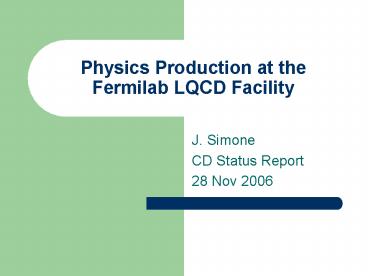Physics Production at the Fermilab LQCD Facility PowerPoint PPT Presentation
1 / 13
Title: Physics Production at the Fermilab LQCD Facility
1
Physics Production at the Fermilab LQCD Facility
- J. Simone
- CD Status Report
- 28 Nov 2006
2
Fermilab LQCD Facility is a Community Resource
Resource allocations based on project proposals
submitted to the USQCD Scientific Allocations
Committee.
3
Ten allocated projects in 2006
- Heavylight Mackenzie 20 collaborators
- Charmonium Kronfeld 6 collaborators
- MILC lattice Sugar 10 collaborators
- Nuclear Physics LQCD Savage 3 collaborators
- Mix BK Laiho 2 collaborators
- HPLQCD Lepage 13 collaborators
- ?QCD Liu 15 collaborators
- Dynamical Chiral Edwards 2 collaborators
- Lattice SUSY Catterall
- Hazenfratz Horvath
4
Allocations and usage by project
5
Capacity and Usage Comments
- July November represents 10 TF-months
- This allocation Year 34.5 TF-months
- A 30 allocation usage to date is on track
- MILClat project is now starting on kaon. It will
consume 24,000 core-hrs per day of running and
use 42 of kaons nodes. - Heavlight project will soon start 3-pt runs on
the fine lattice. This will require bulk of the
remaining allocation for this year.
6
Scientific Progress Reports at LATTICE 2006
- D and B meson decay constants at a0.09 fm and
a0.15 fm lattice spacings. - B?? l? form factors at a0.12 fm lattice spacing.
- D?B l? form factor at a0.12 fm lattice spacing.
- Charmonium and Bottomonium spectra at a0.09,
0.12, 0.15 and 0.18 fm. - B-Bbar mixing matrix elements at a0.12 fm.
- HQET parameters ?bar, ?1 and charm quark mass.
7
LQCD Software Frameworks
Project MILC QMP QDP QIO Chroma QMP QDP QIO Fermiqcd Canopy
Heavylight X Fnal-io X Fnal-io X Fnal-io
MILClat X
mixBK X
NPQCD X
8
Software Frameworks
- Separate library builds for every combination of
MPI (infiniband vs myrinet) and compiler (gcc or
intel vs portland) users require. - Separate pion (32-bit ABI) and kaon (64-bit ABI)
builds. - Configure/make for each build, but no workflow to
do all library builds on a cluster. - Minimal or no automatic testing of builds e.g.
make check. Differences in MPI implementations
and cluster user environments complicate parallel
testing. - SciDAC libraries QMP(MPI), QLA, QDP, QDP, QIO
are installed and in production use on both pion
and kaon clusters. - Chroma also installed and in production use on
both clusters.
9
Production Issues
Primary concerns are cluster (node/network)
reliability and I/O related issues
- Impact of file corruption caused by bad pion hard
disks - Role of dcache
- I/O requirements for analysis of 483 x 128
lattices
10
File corruption
- Caused by defective RAM cache memory in hard
drive electronics Not caught by drive CRC
checks! - Affects only i/o done from newer pion nodes.
- First noticed in data from 403 x 96 decay
constant run. (24 TB of intermediate files) - Projects involving external users minimally
affected? Production ramped up after problem
identified / mitigated. Just re-ran after
occasional checksum error? - Decay constant workflow involves up to five
separate drives per configuration. Tracking disk
provenance means awk / grep scripts to correlate
application logs and PBS job logs. - Fnal-io always checksums data. Used to require
user at application level to test checksums.
Tests now at library level! - Checksums persist in .info files separate from
data tests only possible if users propagate
.info files.
11
File corruption assessment
- Final data products potentially tainted by
corrupt i/o were identified data provenance and
scan for outliers. Small overlap between outliers
and provenance tracking. - Suspect files from coarse and smaller lattices
regenerated. New and old suspect files compared.
Typically only a handful of errors affecting 1st
or 2nd significant digits. Many errors of smaller
magnitudes. - Subset of affected 403 x 96 data regenerated. So
far, data errors do not appear to shift the
values of decay constants. - Test runs on kaon now being used to rerun some
remaining suspect fine lattice production from
pion. Also tests application codes on kaon.
12
Role of Dcache
- volatile dcache is used as a distributed
cluster file system. - Production on both clusters now critically
depends upon volatile dcache. Potential single
point of failure. - Vexing issue offline disk cache leads to a
stalled dccp. Batch jobs die when max node-hrs
limit reached. Eats resources! - Concern large data sets will soon need to be
segmented into (many) multiple files written in
parallel. How well will dcache perform? - Rely on public dcache for tape backed storage.
Downtime also impacts production on clusters. - Grid tools MILClat project and ILDG will need
SRM access to both public and volatile dcache.
Access rights via lqcd and ildg VOs.
13
I/O Requirements and big lattices
- I/O can no longer be streamed through a single
node. For a 483 x 128 lattice upwards of 20-30
of runtime can be spent doing single stream i/o! - sciDAC QIO library supports parallel i/o
segmenting data in separate files. Desirable to
transition applications to QIO. - Applications now use /scratch for i/o. dccp used
to copy files in/out of dcache. Redundant copies! - Desirable for applications to do i/o directly
from dcache. Need to overload i/o calls in QIO
with libdcap replacements. - QIO modifications done but not folded into QIO
release. - QIO needs to be validated with most recent
libdacp release. Need both 32- and 64-bit ABI
versions.

